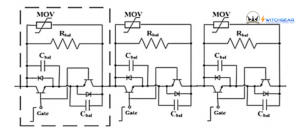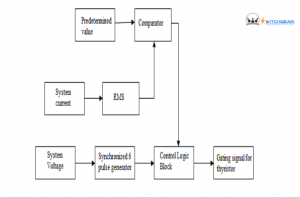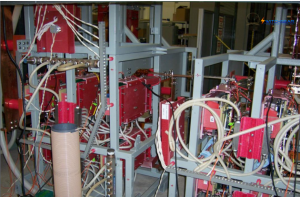
Fault Current Limiters role in system:
In today circumstances, due to the rapid development of smart grid network the occurrence of fault become high. The levels of fault current in many places have often exceeded the withstand capacity of existing power system equipment. As a result, security, stability and reliability of power system will be negatively affected. Thus, limiting the fault current of the power system to a safe level can greatly reduce the risk of failure to the power system equipment due to high fault current flowing through the system. Because of that, there is no surprise to fault current limiting technology has become a hot spot of fault protection research since this technology can limit the fault current to a low level. In power system design view, limiting the fault current to a low level can reduce the design capacity of some electrical equipment in the power system. This will lead to the reduction to the investment cost for high capacity circuit breakers and construction of new transmission line. Consequently, from both technical and economical points of view, fault current limiting technology for reducing short circuit current is needed.
Fault current limiters (FCLs) are special power system devices used to mitigate and lower high short-circuit currents to much more manageable levels for existing protection equipment like circuit breakers (CBs). FCLs are generally installed with the goal to lower the available fault current to a level the CB is capable of interrupting safely prior to the CB beginning its opening operation. The FCL limits the fault current to a preset level based on the particular system configuration and system conditions. In the past, engineers were forced to either upgrade existing equipment to protect the system from the increased short-circuit capacity (if replacements can safely interrupt the new short-circuit level), or they must find a way to lower the short-circuit rating such as bus splitting, increase impedance of transformer, etc. The FCL allows the engineer to apply the chosen technology to avoid a full system upgrade of protection equipment like circuit breakers, which can be rather costly.
Solid-State FCLs:
Fault current limiters (FCL) display great capability in limiting the fault currents in power system networks. There are two main major technologies to limit the fault currents; one is based on upper conductors and the other on solid state semiconductors devices. Solid state fault current limiters (SSFCL) have faster response speeds, have smaller installation space requirements and are relatively easier to maintain, so they are of interest to many researchers.
To employ fault current limiters in transmission and distribution systems, there are several practical application issues that need to be investigated. One of them is protective coordination with relays. Much research is interested in the study of protective coordination for the application of fault current limiters in power transmission and distribution systems.
The SSFCL is an intelligent power-electronics device which is modular in design and can provide current limiting or current interrupting capabilities. It can be applied to variety of applications from distribution class to transmission class power delivery grids and networks. It can also be applied to single major commercial and industrial loads and distributed generator supplies. The active switching of devices can be further utilized for protection of substation transformers. The stress on the system can be reduced substantially improving the life of the power system. It minimizes the voltage sag by speedy elimination of heavy fault currents and promises to be an important element of the utility power system.
The SSFCL applications:
- Bus tie applications:
The SSFCL may be used directly in a transformer bus, as substation bus tie and in a high capacity tie for asset/load tie between substations.
- Radial feeder applications:
The SSFCL may be applied in the output of an Independent Power Producer, or a radial feeder application, where a specific level of let-through current will be required to support downstream relay protection coordination.
The SSFCL uses semiconductor switches such as the Insulated gate bipolar transistor (IGBT), emitter turn-off thyristor (ETO), gate turn-off thyristor (GTO), integrated atecommutated thyristor (IGCT), and other various devices. A SSFCL conducts current through the semiconductor switches in normal operation, and upon a short circuit, the semiconductors are gated “OFF” and force the fault current into a parallel branch impedance. The parallel impedance limits the fault current to a level the system can handle, and a breaker clears the fault some time later. A common design requirement for FCL is to be able to limit the fault current for 60 s before a breaker operates. An example of an SSFCL is shown in Fig 1.

Fig 1: SSFCL schematic diagram
The control system of the SSFCL:
The control system of the SSFCL is shown in term of block diagram in Fig 2. In the operation of SSFCL, fault current need to be detected promptly before it becomes harmful to other equipment. The fault current detection is done by comparing RMS current level with a predetermined reference value. The output from the comparator used to generate switching signals for the thyristors.

Fig 2: Control system of the SSFCL
The SSFCL can allow the user to set a desired fault current level or a window of levels in an effort to minimize existing protection settings. For example, the SSFCL may use the concept of pulse width modulation (PWM) to vary the duty ratio of the semiconductor switches for the system to experience a fault current level set by the user. A maximum fault current level and a minimum fault current level may be set.
If the semiconductor devices are rated high enough, the SSFCL may be permitted to operate as a solid-state circuit breaker (SSCB) and interrupt the current instead of just limiting the current.
Design concerns for the SSFCL include over voltages, exceeding the rate of rise ratings in both voltage and current (dv/dv and di/dt) for the semiconductor switches, conduction losses, high-side gate driver, absorbing the energy in the system due to the inductances in the system during the turn-off period, temperature rises, and withstanding the full system voltage after turn-off. Generally, a metal oxide varistor (MOV), also known as a surge arrestor, is used to protect the switches against overvoltage. Although there are many design considerations for each application, the benefits of a SSFCL may justify its use, and SSFCL is one of the most promising technologies for the future grid. With the introduction of silicon-carbide (SiC) as the material of choice for semiconductor switches, power ratings should only increase making the SSFCL more attractive as this technology matures.
We can see an example 15.5 kv Solid State Fault Current Limiter in Fig 3 under factory test:

Fig 3: 15.5 kv Solid State Fault Current Limiter under factory test
Summery:
To interrupt the current, the SSFCL must rapidly insert an energy-absorbing element (e.g. resistor) into the circuit to limit the fault current. In addition to limiting the fault current, the SSFCL can also
limit the inrush current (soft start capability), even for capacitive loads, by gradually phasing in the switching device rather than making an abrupt transition from an open to a closed position.
A solid state fault current can offer the following advantages:
• limited fault current
• limited inrush current (soft start), even for capacitive loads
• repeated operations with high reliability and without wear-out
• reduced switching surges
• improved power quality for unfaulted lines.
By limiting the current, we achieve fault isolation and better network protection, taking care of most of the distribution system situations that result in voltage sags, swells, and power outages.
Thus the SSFCL can substantially improve the power quality through fault current limiting and inrush current reduction.



